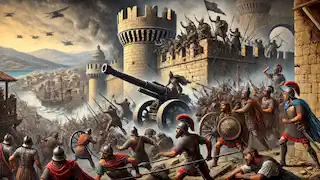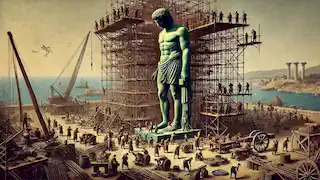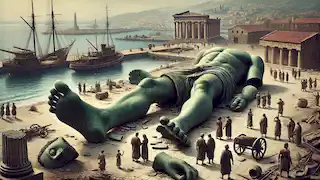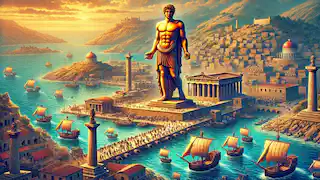In the azure waters of the Aegean Sea, just off the coast of modern-day Greece, lies the island of Rhodes. Renowned for its strategic location and rich history, this island was once the home of one of the Seven Wonders of the Ancient World—the Colossus of Rhodes. Towering over the harbor, the Colossus stood as a symbol of freedom, resilience, and triumph. This story takes you through the legendary origins, construction, and eventual fall of the great statue that once graced the island. Let us embark on a journey to discover the tale of the Colossus, a giant both in its physical form and in the legacy it left behind. The island of Rhodes had long been a jewel in the Mediterranean, a crossroads for merchants, sailors, and conquerors alike. However, the tale of the Colossus begins with a great struggle—the siege of Rhodes by the Macedonian general, Demetrius Poliorcetes, also known as the Besieger. In 305 BCE, the powerful army of Demetrius sailed to Rhodes, determined to subjugate the island and bring it under Macedonian control. Rhodes, though small in size, was fiercely independent. The Rhodians had aligned themselves with Ptolemy I of Egypt, a rival of Demetrius, and this act of defiance brought the wrath of the Macedonian general upon them. For over a year, the siege continued as Demetrius’s forces attacked the city walls with powerful siege engines, including his infamous "Helepolis"—a towering, mobile fortress that could launch devastating projectiles. Despite their superior numbers and technology, the Macedonians failed to break the spirit of the Rhodians. With help from their allies, including the Egyptians, the Rhodians mounted a staunch defense, fending off attack after attack. The citizens worked together, tirelessly repairing their walls, manning their defenses, and ensuring that their city would not fall. Finally, in 304 BCE, after nearly two years of relentless siege, Demetrius withdrew his forces. In his haste to leave, he abandoned many of his siege machines, including the mighty Helepolis. The Rhodians had not only survived—they had triumphed. Their resilience and unity had seen them through, and now they sought to commemorate their victory in a way that would forever remind the world of their strength. Following their victory, the Rhodians deliberated on how to celebrate their hard-fought freedom. The idea of erecting a statue soon emerged, a monument that would not only honor their victory over Demetrius but also pay homage to Helios, the sun god and their divine protector. Helios, it was believed, had watched over Rhodes during the siege, ensuring that the islanders would emerge victorious. The project was ambitious, and the Rhodians turned to Chares of Lindos, a renowned sculptor, to bring their vision to life. Chares had been a student of Lysippos, a master sculptor known for his colossal statues, and it was Chares who now faced the daunting task of designing and building a statue worthy of the gods. The statue was to stand at the entrance of the harbor, its sheer size meant to inspire awe in all who sailed into the port of Rhodes. Helios would stand with his legs apart, towering over ships as they passed between them, a beacon of freedom and strength for the island. The statue would be made of bronze, and its construction would require the melting down of the abandoned siege weapons left behind by Demetrius’s army. The construction of the Colossus was an immense undertaking. The statue was planned to be over 30 meters tall, a height unprecedented in the ancient world. Chares and his team of builders worked tirelessly, using wooden scaffolding to raise the pieces of bronze, and they reinforced the structure with iron and stone to ensure it could withstand the elements. Day by day, the form of Helios grew, his powerful figure taking shape as the embodiment of the island's strength. The Rhodians watched in awe as the statue neared completion. It was more than a symbol of their victory—it was a symbol of their unity, their resilience, and their belief in their destiny. After twelve long years, the statue was completed. The Colossus of Rhodes now stood proudly at the harbor, shining in the sun’s rays, welcoming sailors and merchants from across the Mediterranean. For decades, the Colossus of Rhodes stood as one of the most magnificent man-made structures in the world. Visitors from distant lands marveled at the sight of the towering bronze figure, and its legend spread across the ancient world. Rhodes became a symbol of power and resilience, attracting trade and wealth from every corner of the Mediterranean. The statue of Helios was not only a testament to the Rhodians' past triumph but also a beacon of prosperity for their future. The city flourished, and the Rhodians took pride in the fact that they had created something so enduring, so majestic, that it had become a wonder of the world. Yet, while the statue stood tall, the forces of nature were beyond the control of even the most skilled builders. Rhodes, situated in an earthquake-prone region, was constantly under threat from the tremors that shook the earth beneath it. The people of Rhodes were no strangers to these quakes, but they could not have foreseen what was to come. In 226 BCE, just over 50 years after the Colossus was completed, a devastating earthquake struck the island. The ground trembled violently, and buildings throughout Rhodes crumbled under the force of the shock. The mighty Colossus, once believed to be indestructible, was no match for the power of the earthquake. It is said that the statue snapped at the knees, and the great figure of Helios came crashing down into the harbor, its bronze form shattered and scattered along the waterfront. The Rhodians were devastated. Their beloved statue, the symbol of their freedom and triumph, was now lying in ruins. Offers came from foreign rulers to help rebuild the Colossus, but the Rhodians, interpreting the destruction as a sign of the gods' displeasure, refused. For centuries, the remnants of the Colossus lay where they had fallen, a reminder of both the greatness of Rhodes and the fragility of human achievement. Though the Colossus of Rhodes lay in ruins, its legend only grew with time. Historians, poets, and travelers alike spoke of the towering statue that once dominated the harbor. The image of Helios standing tall, his bronze body gleaming in the sun, persisted in the imaginations of those who heard the tale. The fallen pieces of the statue remained in place for nearly 800 years, and they were said to be so large that it took several men just to wrap their arms around one of the statue's thumbs. The remains of the Colossus continued to draw visitors to Rhodes, long after the statue had fallen. The story of the Colossus also inspired later generations. The concept of building monumental statues as symbols of human achievement can be seen throughout history, from the Statue of Liberty in New York to the Christ the Redeemer statue in Brazil. These modern wonders stand as testaments to the same ideals of freedom, strength, and unity that the Colossus of Rhodes once represented. Though the statue itself no longer stands, its spirit lives on in the hearts and minds of people across the world. The Colossus of Rhodes remains one of the most iconic symbols of the ancient world, a reminder of both the heights of human ambition and the inevitability of nature's power. {{{_03}}} In modern times, there have been numerous attempts to rediscover and even rebuild the Colossus of Rhodes. Archaeologists have searched for the exact location of the statue's remains, hoping to uncover clues about how the statue was constructed and how it met its end. Though no definitive evidence has been found, the allure of the Colossus continues to captivate historians and engineers alike. There have even been proposals to build a new Colossus, one that would once again stand at the entrance of the harbor, just as the original had done over 2,000 years ago. Some argue that rebuilding the Colossus would be a fitting tribute to the island's heritage and a way to honor the legacy of the ancient Rhodians. However, others believe that the memory of the original Colossus is enough. The fallen statue, with all its grandeur and its tragic fate, stands as a monument in its own right—a reminder of the impermanence of even the greatest human achievements. To rebuild the statue, they argue, would be to miss the point of its legacy. Yet, the dream persists. Whether in history books, in modern art, or in the imaginations of those who dream of great monuments, the Colossus of Rhodes lives on. The tale of the Colossus of Rhodes is one of triumph and tragedy, of human ingenuity and the power of the natural world. From its conception as a symbol of freedom to its construction as a wonder of the world, the Colossus represented the highest aspirations of the people of Rhodes. Though it stood for only a short time, its legacy has endured for millennia, inspiring awe and admiration in all who hear its story. The Colossus was not just a statue; it was a statement to the world that the people of Rhodes would not be conquered, that they would rise from adversity stronger and more united . In its fall, the Colossus also taught a valuable lesson—that even the greatest achievements are subject to the forces of nature and time. As we look back on the tale of the Colossus, we are reminded that the true wonder lies not in the statue itself, but in the spirit of the people who created it. They built the Colossus to honor their past, to celebrate their victory, and to inspire future generations. And in that sense, the Colossus of Rhodes, though fallen, will forever stand tall.The Battle for Freedom

The Vision of the Colossus
The Colossus Reigns

The Legacy of the Colossus
Rediscovering the Colossus

Conclusion
The Tale of the Colossus of Rhodes
Reading Time: 9 min

About Story: The Tale of the Colossus of Rhodes is a Legend Stories from greece set in the Ancient Stories. This Descriptive Stories tale explores themes of Courage Stories and is suitable for All Ages Stories. It offers Historical Stories insights. The rise and fall of an ancient wonder, symbolizing triumph and tragedy.

















